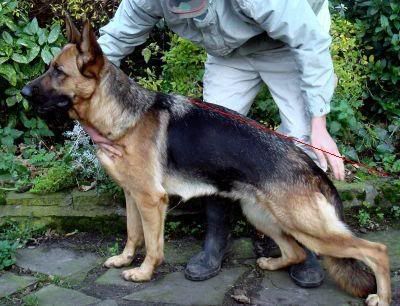
This is a placeholder text
Group text
by funky munky on 18 January 2009 - 16:01
by pod on 18 January 2009 - 16:01

by pod on 18 January 2009 - 16:01
Hi Liz. No that's certainly not a correct backline IMO. The dog is hideously exaggerated. I suppose you could say that the back between withers and croup is straight, but to me it looks weak.
If you are interested, the back and topline that I consider correct is unexaggerated in slope and curve. A superb example, Uran -
http://www.pedigreedatabase.com/gsd/pedigree/56.html
by funky munky on 18 January 2009 - 16:01
by jaymesie51 on 18 January 2009 - 16:01
jim h
by Sue B on 18 January 2009 - 17:01
I dont think so, unless you are trying to tell us that the back on the Athlete shown in the photo does not have a convex curve between shoulders and rump? See the straight line drawn, are you seriously telling me her back is not raised up in an arch between her shoulders and rump?
Regards
Sue B
by shepherdmom on 18 January 2009 - 19:01
From The AKC standard:
Topline - The withers are higher than and sloping into the level back. The back is straight, very strongly developed without sag or roach, and relatively short.
Transmission -The typical smooth, flowing gait is maintained with great strength and firmness of back. The whole effort of the hindquarter is transmitted to the forequarter through the loin, back and withers. At full trot, the back must remain firm and level without sway, roll, whip or roach. Unlevel topline with withers lower than the hip is a fault.
From the UKC standard:
Gait - Correct gait is an essential feature of the German Shepherd Dog. When trotting, it moves with along, efficient stride that is driven by a powerful forward thrust from the hindquarters. The rear leg, moving forward, swings under the foreleg and touches down in front of the point where the forefoot left an imprint. \The result of this “overreaching” is that one rear leg passes outside its corresponding front leg and the other passes inside its corresponding front leg. This is a breed characteristic and should not be penalized as long as the body is straight in relationship to the direction of movement. As the rear leg moves backward, the body is propelled forward. The front and rear feet remain close to the ground throughout. When trotting, the back remains firm and level. As the speed of the trot increases, there is a tendency to single track. Correct movement must be evaluated from front and rear as well as the side.
Body - A properly proportioned German Shepherd Dog is longer (measured from prosternum to point of buttocks) than tall (measured from the withers to the ground) in a ratio of 10 to 9. The length is derived from proper construction of forequarters and hindquarters and not from length of back. The line of the back slopes downward from the withers into a straight, strongly developed, and relatively short back. Ribs are long and and extend well back, resulting in a short, broad loin. The croup is long and sloping. Viewed from the front, the chest is deep and well-filled. From the side, the forechest extends in front of the forelegs and the brisket down to the elbows. Tuck up is moderate.
by missbeeb on 18 January 2009 - 19:01
So... it's part of the problem then Shepherdmom, different standards, we have the same problem here, it's ludicrous. There should only be one Breed Standard... the German one imo.
by Liebe on 18 January 2009 - 19:01
Surely if we are able to compete under FCI rules then all breed standards within FCI countries should be the same? That way all competitors should start at the same point.
by shepherdmom on 19 January 2009 - 03:01
Missbeeb, I'm not sure what standards you have read that have not mentioned level or straight.
This is from the FCI standard that is linked on the database here.
With his head thrust forward and a slightly raised tail, a balanced and even trotter will have a topline that falls in moderate curves from the tip of the ears over the neck and level back through the tip of the tail.
The back, including the loins, is straight and strongly developed yet not too long between the withers and the croup. The withers must be long and high, sloping slightly from front to rear, defined against the back into which it gently blends without breaking the topline.
Contact information Disclaimer Privacy Statement Copyright Information Terms of Service Cookie policy ↑ Back to top





